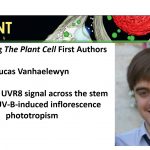Plant Science Research Weekly: July 12th
Review: Synthetic biology in photosynthetic microbes: present and future
 Photosynthetic microbes are emerging models for synthetic biology applications since they possess relatively simple physiology and cellular organization, fast growth in liquid culture, and facile genetic manipulation. In this paper, Vavitsas et al. review current synthetic biology tools and applications applied to cyanobacteria and algae. Cyanobacteria, such as Synechocystis, Synechococcus or Nostoc, offer excellent features to be used as cell factories for industrial biochemical production. They have high metabolic flexibility, fast growth and a rapid acclimation to environmental fluctuation. Eukaryotic systems are another alternative; algae such as Chlamydomonas reinhardtii and Phaeodactylum tricornutum now have information at the system-level for proteomics, transcriptomics, and genomics, which in combination with fast growth and easy culture at large scale make them very attractive for metabolic engineering applications. Currently available genetic parts (promoters, terminators, reporter genes), vectors and genome editing tools are listed, and current challenges and future directions are also discussed. (Summary by Humberto Herrera-Ubaldo). Plant Physiol. 10.1104/pp.19.00345
Photosynthetic microbes are emerging models for synthetic biology applications since they possess relatively simple physiology and cellular organization, fast growth in liquid culture, and facile genetic manipulation. In this paper, Vavitsas et al. review current synthetic biology tools and applications applied to cyanobacteria and algae. Cyanobacteria, such as Synechocystis, Synechococcus or Nostoc, offer excellent features to be used as cell factories for industrial biochemical production. They have high metabolic flexibility, fast growth and a rapid acclimation to environmental fluctuation. Eukaryotic systems are another alternative; algae such as Chlamydomonas reinhardtii and Phaeodactylum tricornutum now have information at the system-level for proteomics, transcriptomics, and genomics, which in combination with fast growth and easy culture at large scale make them very attractive for metabolic engineering applications. Currently available genetic parts (promoters, terminators, reporter genes), vectors and genome editing tools are listed, and current challenges and future directions are also discussed. (Summary by Humberto Herrera-Ubaldo). Plant Physiol. 10.1104/pp.19.00345
Opinion: Plants neither possess nor require consciousness
 Don’t miss this opinion article by Taiz et al, which tries to close the door on the eternal question of how to describe and label the ability of plants to perceive and respond to their environment. Are plants intelligent? Can they learn? Do they have consciousness? The article draws on recent studies of animal neuroscience and brain structures to try to define the minimum standard for consciousness. The authors also review and deconstruct recent studies that have been interpreted to suggest that plants experience pain and are capable of associative learning, and they critique the trend to anthropomorphize plants. Given the popularity of such views, and the opportunity they provide for discussion, this is an intriguing paper to share with students. (Summary by Mary Williams, image from Wikimedia Commons). Trends Plant Sci. 10.1016/j.tplants.2019.05.008
Don’t miss this opinion article by Taiz et al, which tries to close the door on the eternal question of how to describe and label the ability of plants to perceive and respond to their environment. Are plants intelligent? Can they learn? Do they have consciousness? The article draws on recent studies of animal neuroscience and brain structures to try to define the minimum standard for consciousness. The authors also review and deconstruct recent studies that have been interpreted to suggest that plants experience pain and are capable of associative learning, and they critique the trend to anthropomorphize plants. Given the popularity of such views, and the opportunity they provide for discussion, this is an intriguing paper to share with students. (Summary by Mary Williams, image from Wikimedia Commons). Trends Plant Sci. 10.1016/j.tplants.2019.05.008
Review: Engineered male sterility by early anther ablation using the pea anther-specific promoter PsEND1
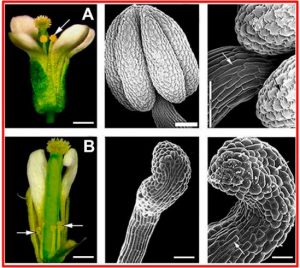 Male sterility in seed production could be used to increase crop yields, eliminate pollen allergies or avoid gene flow between genetically modified plants and other species. Here, Roque et al. describe a system to engineer nuclear male sterile plants using the pea Pisum sativum ENDOTHECIUM 1 (PsEND1) promoter. Immunolocalization, Northern blot and RNA in situ hybridization analyses identified and localized PsEND1 expression in pea anthers at very early stages. In transformed dicot and monocot plants (Arabidopsis, tobacco, oilseed rape, tomato, rice and wheat), the PsEND1 promoter fused with uidA reporter gene showed anther-specific expression. A chimeric construct was generated by joining the PsEND1 promoter, the ribonuclease barnase gene and, its inhibitor, the barstar gene. The PsEND1::barnase-barstar construct directed the expression of the barnase to anther tissues, producing genetic cell ablation and providing efficient male sterility in all the plants tested. The anther development was arrested at early stages and no pollen sacs were formed. Additional effects in the male sterile plants were observed such as increased plant longevity, branching, and number of flower and production of parthenocarpic fruits with increased yield and quality. (Summary by Ana Valladares). Front. Plant Sci. 10.3389/fpls.2019.00819
Male sterility in seed production could be used to increase crop yields, eliminate pollen allergies or avoid gene flow between genetically modified plants and other species. Here, Roque et al. describe a system to engineer nuclear male sterile plants using the pea Pisum sativum ENDOTHECIUM 1 (PsEND1) promoter. Immunolocalization, Northern blot and RNA in situ hybridization analyses identified and localized PsEND1 expression in pea anthers at very early stages. In transformed dicot and monocot plants (Arabidopsis, tobacco, oilseed rape, tomato, rice and wheat), the PsEND1 promoter fused with uidA reporter gene showed anther-specific expression. A chimeric construct was generated by joining the PsEND1 promoter, the ribonuclease barnase gene and, its inhibitor, the barstar gene. The PsEND1::barnase-barstar construct directed the expression of the barnase to anther tissues, producing genetic cell ablation and providing efficient male sterility in all the plants tested. The anther development was arrested at early stages and no pollen sacs were formed. Additional effects in the male sterile plants were observed such as increased plant longevity, branching, and number of flower and production of parthenocarpic fruits with increased yield and quality. (Summary by Ana Valladares). Front. Plant Sci. 10.3389/fpls.2019.00819
ALOG transcription factors influence the morphological diversity of plant lateral organs
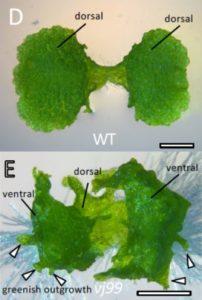 Land plants evolved from freshwater streptophytic algae over 450 million years ago and have since separated into morphologically diverse lineages. A key feature in the transition from aquatic to terrestrial life was the development of 3D body plans with lateral organs. In a new preprint, Naramoto and colleagues describe the identification of an evolutionarily conserved ALOG (Arabidopsis LSH1 and Oryza G1) family protein that regulates meristem identity and lateral organ development in an early-divergent model system. Forward genetic screening in the thalloid liverwort Marchantia polymorpha identified mutants of the ALOG gene MpTAWAWA (Mptaw) that develop numerous outgrowths from the margins of thalli relative to wild-type plants. These outgrowths resemble ventral scales that normally appear on the underside of liverworts and help anchor the plant body to the substrate. Intriguingly, Mptaw mutant thalli lack ventral scales. Furthermore, in Mptaw apical meristems show a dispersed notch-like area relative to wild-type. An apical meristem-associated marker gene expression (YUC2A::GUS) revealed that this dispersed notch-like area is indeed meristem-like in identity and is likely caused by a lack of cell division that would normally separate bifurcating meristems. In Oryza sativa (rice), the ALOG protein G1 is involved in the development of sterile lemmas (a small leaf-like lateral organ present on the rice spikelet) such that g1 mutants display abnormally enlarged lemmas. Excitingly, the ectopic expression of MpTAW in g1 mutants rescued this lateral organ defect, demonstrating functional conservation in ALOG function between these two phylogenetically-distant plant lineages. Collectively, this work underscores the power of such macroevolutionary evo-devo analyses and identifies ALOG transcription factors as critical regulators of lateral organ development in plants. (Summary by Phil Carella) bioRxiv
Land plants evolved from freshwater streptophytic algae over 450 million years ago and have since separated into morphologically diverse lineages. A key feature in the transition from aquatic to terrestrial life was the development of 3D body plans with lateral organs. In a new preprint, Naramoto and colleagues describe the identification of an evolutionarily conserved ALOG (Arabidopsis LSH1 and Oryza G1) family protein that regulates meristem identity and lateral organ development in an early-divergent model system. Forward genetic screening in the thalloid liverwort Marchantia polymorpha identified mutants of the ALOG gene MpTAWAWA (Mptaw) that develop numerous outgrowths from the margins of thalli relative to wild-type plants. These outgrowths resemble ventral scales that normally appear on the underside of liverworts and help anchor the plant body to the substrate. Intriguingly, Mptaw mutant thalli lack ventral scales. Furthermore, in Mptaw apical meristems show a dispersed notch-like area relative to wild-type. An apical meristem-associated marker gene expression (YUC2A::GUS) revealed that this dispersed notch-like area is indeed meristem-like in identity and is likely caused by a lack of cell division that would normally separate bifurcating meristems. In Oryza sativa (rice), the ALOG protein G1 is involved in the development of sterile lemmas (a small leaf-like lateral organ present on the rice spikelet) such that g1 mutants display abnormally enlarged lemmas. Excitingly, the ectopic expression of MpTAW in g1 mutants rescued this lateral organ defect, demonstrating functional conservation in ALOG function between these two phylogenetically-distant plant lineages. Collectively, this work underscores the power of such macroevolutionary evo-devo analyses and identifies ALOG transcription factors as critical regulators of lateral organ development in plants. (Summary by Phil Carella) bioRxiv
The EDS1-SAG101 complex regulates TNL-based immunity in Solanaceous plants
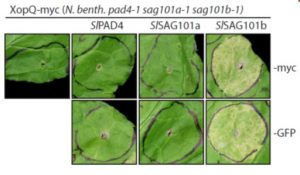 Microbial pathogens secrete virulence effector proteins into host cells to suppress basal plant defenses. Plant resistance (R) receptors induce robust immune signaling after directly or indirectly detecting such effector-mediated host manipulation. In Arabidopsis, immunity transduced through many TNL (TIR-NBS-LRR) class R receptors requires heterodimeric complexes consisting of the lipase-like EDS1 (Enhanced Disease Resistance1) and sequence-related homologs PAD4 (Phytoalexin Deficient4) or, to a lesser degree, SAG101 (Senescence Associated Gene101). In a new study, Gantner et al. explore this paradigm using functional genomic techniques in Nicotiana benthamiana. CRISPR/Cas9-generated knockouts of eds1 family genes supported a conserved role for NbEDS1 in regulating Roq1 (TNL) immunity activated by the XopQ effector from the bacterial pathogen Xanthomonas campestris. Surprisingly, the SAG101b isoform, and not PAD4 or SAG101a, was required to form functional TNL immune-competent EDS1-SAG101 complexes. Cross species complementation assays further revealed a strict dependency for intra-species (from Arabidopsis or tomato) EDS1-PAD4 pairs in Arabidopsis, whereas AtEDS1-AtSAG101 was not transferable to N. benthamiana. Genetic chimeras between SAG101b (functional) and SAG101a (non-functional) revealed an apolar patch of amino acid residues within the EP domain that was essential for TNL immunity. Collectively, this work provides novel insights into the functional diversity of TNL immune signalling mechanisms in flowering plants. (Summary by Phil Carella) Plant Cell 10.1105/tpc.19.00099
Microbial pathogens secrete virulence effector proteins into host cells to suppress basal plant defenses. Plant resistance (R) receptors induce robust immune signaling after directly or indirectly detecting such effector-mediated host manipulation. In Arabidopsis, immunity transduced through many TNL (TIR-NBS-LRR) class R receptors requires heterodimeric complexes consisting of the lipase-like EDS1 (Enhanced Disease Resistance1) and sequence-related homologs PAD4 (Phytoalexin Deficient4) or, to a lesser degree, SAG101 (Senescence Associated Gene101). In a new study, Gantner et al. explore this paradigm using functional genomic techniques in Nicotiana benthamiana. CRISPR/Cas9-generated knockouts of eds1 family genes supported a conserved role for NbEDS1 in regulating Roq1 (TNL) immunity activated by the XopQ effector from the bacterial pathogen Xanthomonas campestris. Surprisingly, the SAG101b isoform, and not PAD4 or SAG101a, was required to form functional TNL immune-competent EDS1-SAG101 complexes. Cross species complementation assays further revealed a strict dependency for intra-species (from Arabidopsis or tomato) EDS1-PAD4 pairs in Arabidopsis, whereas AtEDS1-AtSAG101 was not transferable to N. benthamiana. Genetic chimeras between SAG101b (functional) and SAG101a (non-functional) revealed an apolar patch of amino acid residues within the EP domain that was essential for TNL immunity. Collectively, this work provides novel insights into the functional diversity of TNL immune signalling mechanisms in flowering plants. (Summary by Phil Carella) Plant Cell 10.1105/tpc.19.00099
Evolution of cold acclimation in the temperate grass subfamily Pooideae
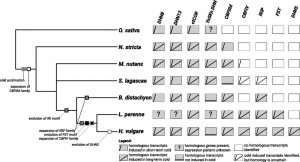 In the grass family (Poaceae), the subfamily Pooideae, which includes economically important species like wheat, barley and forage grasses like ryegrass, dominates cold temperate habitats, although the ancestors of this group probably were adapted to tropical climates. Schubert et al. investigated the evolution to cold acclimation in the Pooideae subfamily. A cold acclimation followed by freezing treatment was applied to nine species representing the major clades in the Pooideae subfamily. All acclimated plants had a higher regrowth capacity after freezing compared to non-acclimated ones. Transcriptomic analysis in five species was performed before and after cold treatment and high confidence ortholog groups (HCOGs) were assembled. Sixteen genes that shared the same cold response in the same direction in the five species were identified. Further phylogenetic analysis of cold acclimation related genes showed that some of these genes evolved early while some others were conserved such as dehydrin 8 and 13. (Summary by Cecilia Vasquez-Robinet) Plant Phys. 10.1104/pp.18.01448
In the grass family (Poaceae), the subfamily Pooideae, which includes economically important species like wheat, barley and forage grasses like ryegrass, dominates cold temperate habitats, although the ancestors of this group probably were adapted to tropical climates. Schubert et al. investigated the evolution to cold acclimation in the Pooideae subfamily. A cold acclimation followed by freezing treatment was applied to nine species representing the major clades in the Pooideae subfamily. All acclimated plants had a higher regrowth capacity after freezing compared to non-acclimated ones. Transcriptomic analysis in five species was performed before and after cold treatment and high confidence ortholog groups (HCOGs) were assembled. Sixteen genes that shared the same cold response in the same direction in the five species were identified. Further phylogenetic analysis of cold acclimation related genes showed that some of these genes evolved early while some others were conserved such as dehydrin 8 and 13. (Summary by Cecilia Vasquez-Robinet) Plant Phys. 10.1104/pp.18.01448
GmFT2a and GmFT5a collectively controls flowering of soybean
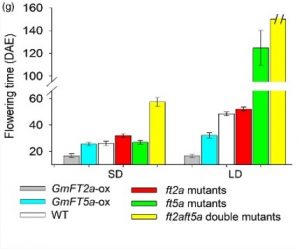 Soybean [Glycine max (L.) Merr.] is a globally important high-protein crop, whose breeding is an ongoing, important objective for plant biologists. Since soybean is a short-day plant, controlling flowering time is a key step to influence its adaptation to diverse latitudes and farming system. Recently, Yupeng Cai et al found that two classical flowering regulator GmFT2a and GmFT5a, collectively rather than redundantly control flowering time of soybean under different photoperiods. GmFT2a affects flowering prominently under short-day conditions, GmFT5a is mainly responsible for long-day conditions. Double mutant ft2aft5a produced significantly increased numbers of pods and seeds than wild type soybean. These results contribute further insights into the regional adaptability of new soybean varieties, to accelerate molecular breeding for the world. (Summarized by Nanxun Qin) Plant Biotech J. 10.1111/pbi.13199
Soybean [Glycine max (L.) Merr.] is a globally important high-protein crop, whose breeding is an ongoing, important objective for plant biologists. Since soybean is a short-day plant, controlling flowering time is a key step to influence its adaptation to diverse latitudes and farming system. Recently, Yupeng Cai et al found that two classical flowering regulator GmFT2a and GmFT5a, collectively rather than redundantly control flowering time of soybean under different photoperiods. GmFT2a affects flowering prominently under short-day conditions, GmFT5a is mainly responsible for long-day conditions. Double mutant ft2aft5a produced significantly increased numbers of pods and seeds than wild type soybean. These results contribute further insights into the regional adaptability of new soybean varieties, to accelerate molecular breeding for the world. (Summarized by Nanxun Qin) Plant Biotech J. 10.1111/pbi.13199
Effective strategies for rebutting science denialism in public discussions
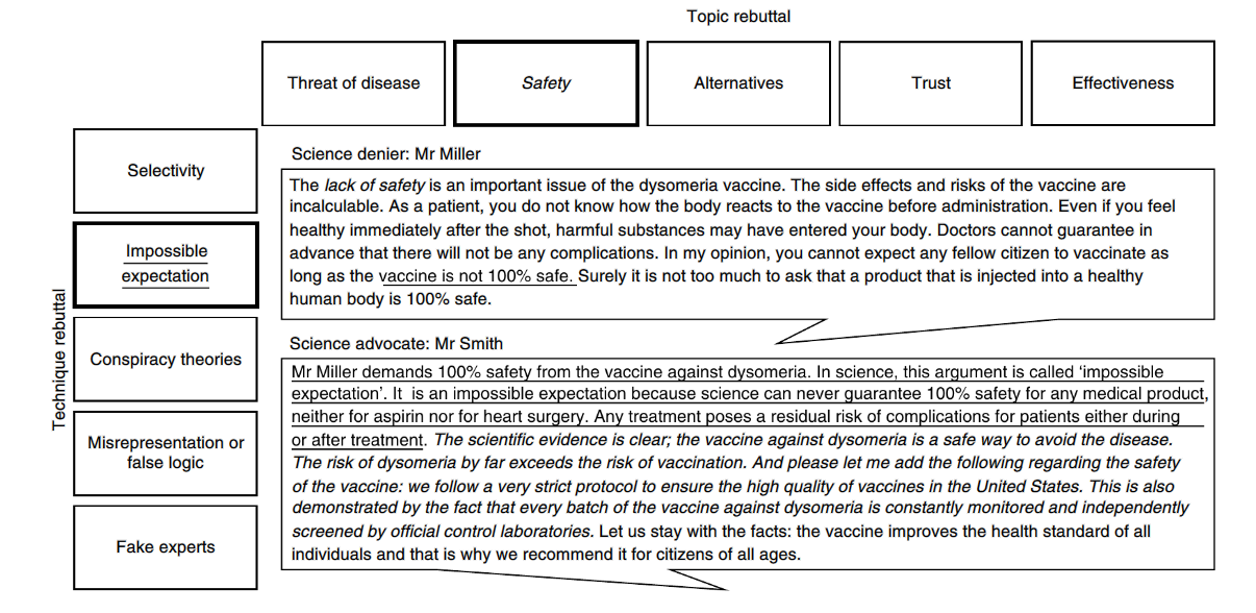 Scientists are often asked to engage in public discourse as a way to counteract science denialism, but it’s not always clear if their efforts can change minds. A new study by Schmid and Betsch suggests that efforts to rebut are worthwhile. They showed subjects videos with climate denial messages about climate change and vaccines, and in some cases followed these with rebuttal videos in which misinformation was corrected or the rhetorical methods of the denialists were challenged. In most cases, rebutting science denialism had a positive impact in the attitudes of the subjects. The authors advocate that scientists should be trained in strategies to rebut topical misinformation and reveal misleading rhetoric. (Summary by Mary Williams) Nature Human Behaviour 10.1038/s41562-019-0632-4
Scientists are often asked to engage in public discourse as a way to counteract science denialism, but it’s not always clear if their efforts can change minds. A new study by Schmid and Betsch suggests that efforts to rebut are worthwhile. They showed subjects videos with climate denial messages about climate change and vaccines, and in some cases followed these with rebuttal videos in which misinformation was corrected or the rhetorical methods of the denialists were challenged. In most cases, rebutting science denialism had a positive impact in the attitudes of the subjects. The authors advocate that scientists should be trained in strategies to rebut topical misinformation and reveal misleading rhetoric. (Summary by Mary Williams) Nature Human Behaviour 10.1038/s41562-019-0632-4



